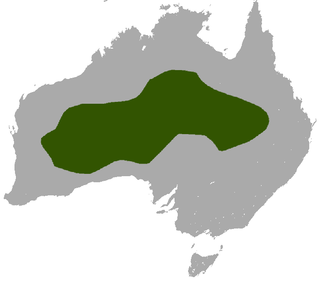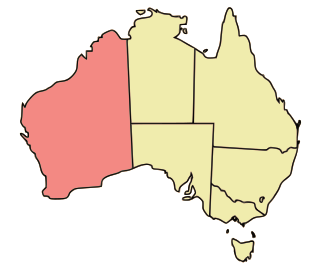
Agrostis is a large and very nearly cosmopolitan genus of plants in the grass family, found in nearly all the countries in the world. It has been bred as a GMO creeping bent grass.

The spinifex pigeon, also known as the plumed-pigeon or gannaway pigeon, is one of three endemic Australian bird species within the genus Geophaps. It occurs within a broader group known as bronzewing pigeons. This species is listed under the International Union for Conservation of Nature (IUCN) Red List category of "least concern". It most frequently occurs in arid and semi-arid habitats containing hummock-forming grasses of the genera Triodia and Plectrachne.

The Wongai ningaui is a tiny carnivorous marsupial native to the arid open grasslands of inland Australia. Their diet is mainly small insects, and occasionally larger prey such as spiders, grasshoppers and cockroaches, which they forage for at the ground and in clumps of spinifex. They have long and untidy fur, grey or gingery brown with longer black hairs, small ears, a narrow muzzle, and possess a partially prehensile tail and feet that allow them to climb. The population occurs sparsely across a wide area and common in favourable habitat, especially in years of good rainfall. Ningaui ridei was first described in 1975, one of two species of a new genus discovered amongst the poorly known mammals of the western regions of Australia.

Cenchrus is a widespread genus of plants in the grass family. Its species are native to many countries in Asia, Africa, Australia, the Americas, and various oceanic islands.

Eriocaulon is a genus of about 400 species of monocotyledonous flowering plants in the family Eriocaulaceae, commonly known as pipeworts.

Lechenaultia is a genus of flowering plants in the family Goodeniaceae, the species native to Australia with one species also occurring in New Guinea. Plants in the genus Lechenaultia are glabrous shrubs or herbs with needle-shaped leaves, more or less sessile flowers with five sepals and five blue, white, or yellow and red petals in two unequal lobes, the fruit an elongated capsule.

Spinifex is a genus of perennial coastal plants in the grass family.
Kevin R. Thiele is currently an adjunct associate professor at the University of Western Australia and the director of Taxonomy Australia. He was the curator of the Western Australian Herbarium from 2006 to 2015. His research interests include the systematics of the plant families Proteaceae, Rhamnaceae and Violaceae, and the conservation ecology of grassy woodland ecosystems. He also works in biodiversity informatics, developing and teaching the development of interactive multi-access keys, and has been involved in the design of software for the Global Biodiversity Information Facility.
Western pebble-mound mouse or Ngadji is a burrowing and mound building rodent in the family Muridae. They occur in the Pilbara, a remote region in the northwest of Australia.

Western Australia occupies nearly one third of the Australian continent. Due to the size and the isolation of the state, considerable emphasis has been made of these features; it is the second largest administrative territory in the world, after Yakutia in Russia, despite the fact that Australia is only the sixth largest country in the world by area, and no other regional administrative jurisdiction in the world occupies such a high percentage of a continental land mass.

Yakirra is a genus of Burmese and Australian plants in the grass family.

Eriachne, commonly known as Wanderrie grass, is a genus of plants in the grass family. Most of the species are found only in Australia, with the ranges of a few extending northward into New Guinea, parts of Asia, and Micronesia.

Ectrosia is a genus of Asian, Australian, and Pacific Island plants in the grass family.
Whiteochloa is a genus of plants in the grass family.

Iseilema, commonly known in Australia as Flinders grass, is a genus of Asian and Australian plants in the grass family.
Triodia stipoides is a species of grass native to the Kimberley region of Western Australia. It is a perennial which grows primarily in the seasonally dry tropics.

Triodia scariosa, is more commonly known as porcupine grass or spinifex, and belongs to the endemic Australian grass genus Triodia. The species is perennial and evergreen and individuals grow in mounds, called hummocks, that reach up to ~1m in height. The leaves are ~30 cm long, 1mm in diameter, needlepointed and rigid, and its inflorescence is a narrow, loose panicle that forms a flowering stalk up to ~2m in height. The name is derived from Latin; Triodia refers to the three-toothed lobes of the lemma, and scariosa is in reference to the thin, dry glume. The species is common to Mallee (MVG14) and Hummock grassland (MVG20) communities, in arid and semi-arid regions of Australia.

Triodia scintillans, the sparkling spinifex, or salt and vinegar chips spinifex is a species of grass in the genus Triodia. It tastes like salt and vinegar potato chips.















